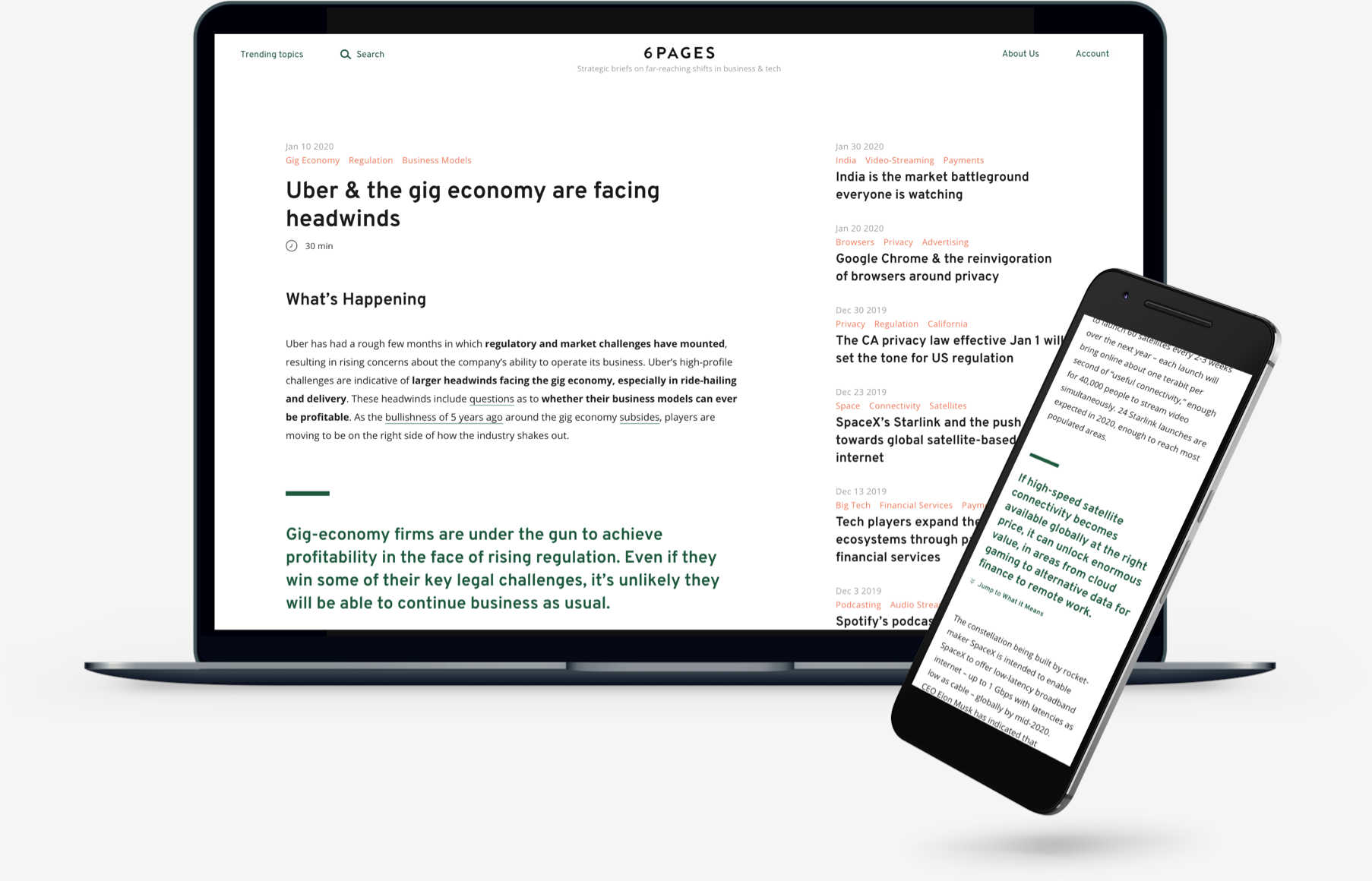“
6Pages write-ups are some of the most comprehensive and insightful I’ve come across – they lay out a path to the future that businesses need to pay attention to.
— Head of Deloitte Pixel
“
At 500 Startups, we’ve found 6Pages briefs to be super helpful in staying smart on a wide range of key issues and shaping discussions with founders and partners.
— Thomas Jeng, Director of Innovation & Partnerships, 500 Startups
“
6Pages is a fantastic source for quickly gaining a deep understanding of a topic. I use their briefs for driving conversations with industry players.
— Associate Investment Director, Cambridge Associates
Read by

Used at top MBA programs including
Apr 18 2025
14 min read
1. The growth of AI big tech and $200-per-month subscriptions
- AI players have come a long way since OpenAI’s GPT-2 (Feb 2019) and ChatGPT (Nov 2022). ChatGPT is now the most downloaded non-gaming app in the world, as of Mar 2025. According to OpenAI CEO Sam Altman, 10% of the world now uses OpenAI's systems. It has an estimated 800M+ weekly active users (WAU), based on what has been reported as well as comments at TED on Apr 11 that it had doubled its compute usage in just the prior few weeks. Those figures could grow once OpenAI releases its open model, which Altman says will be “near the frontier” and “better than any current open-source model out there.”
- OpenAI’s explosive growth over the past 6 months, since Oct 2024 when it had 250M weekly active users, is being driven by a combination of factors. It certainly benefited from the integration of ChatGPT into Apple’s Siri voice assistant (Dec 2024). OpenAI has also released a torrent of tools and features over this period, spurred by competition from Anthropic, DeepSeek, and xAI’s Grok. These include video-generation model Sora (Dec 2024), the Operator browser-using agent (Jan 2025), research assistant Deep Research (Feb 2025), and advanced image generation with its viral “Ghibli effect” (Mar 2025). OpenAI also released o3-mini (Jan 2025), GPT-4.5 (Feb 2025), and o3, o4-mini, and o4-mini-high (Apr 2025) during this time. This past week, OpenAI released the developer-focused GPT-4.1 (a confusingly named successor to GPT-4o) through the API. It also plans to release o3-pro to Pro users “in a few weeks.”
- This is all in line with OpenAI’s focus on becoming a consumer tech company. While OpenAI’s models continue to rank near the top of the leaderboards (although not at the very top), the company seems to have shifted its strategy away from being the leading provider of best-in-class models. Rather than hanging its hat on being a model purveyor, OpenAI instead is aiming to be the next global big tech firm with 1B+ daily active users (DAU). (According to ChatGPT, productivity tools typically see a 30-50% ratio in DAU/WAU.) Reports indicate that OpenAI told potential investors it was aiming for 900M DAU and 2B WAU by 2030.
- After seeing $3.7B in revenue last year, OpenAI is aiming to more than triple revenue to $12.7B by the end of 2025. As of Oct 2024, ChatGPT represented 75% of its revenue and that proportion is certainly higher now. Just 3 weeks ago, OpenAI raised $40B at a $300B post-money valuation on the back of these projections – the largest funding round of all time. ($10B of this round is contingent on OpenAI making a successful for-profit conversion by end of 2025.)
- A big part of ChatGPT’s success has been OpenAI’s optimization of its freemium model. Around May 2024, OpenAI began adding more features to its Free tier, many on a limited-usage basis. Before that, the Free tier would only provide unlimited access to the older GPT-3.5 model. Now, ChatGPT Free includes real-time data and search; access to GPT-4o mini; limited access to GPT-4o (10 messages every 3 hours), o3-mini (10 messages every 6 hours), advanced image generation (3 images per day), file uploads (3 uploads per day), advanced voice mode (15 min per month), and the API ($100/month); and limited access to data analysis, custom GPTs, and code editing (using the ChatGPT desktop app for macOS).
- On the other end of the consumer subscription continuum, OpenAI introduced ChatGPT Pro ($200/month) in Dec 2024. (The in-between ChatGPT Plus subscription priced at $20/month was introduced in Feb 2023.) ChatGPT Pro comes with unlimited access to o1, o3-mini, o3-mini-high, GPT-4o, and advanced voice mode; “extended” limits/access for Deep Research, Sora video generation, image generation, messaging, file uploads, and data analysis; and access to GPT-4.5, o1 pro mode, and the Operator web-browsing agent. Just 7 weeks after launch, OpenAI was reporting that Pro revenue was already outpacing ChatGPT Team subscriptions, which was launched a full year prior.
- A week ago, Anthropic released its own $200/month consumer-grade subscription, called Claude Max. Like OpenAI, Anthropic has had a $20/month subscription (Claude Pro) since 2023. The new Claude Max actually has two price points – $100/month for 5x the usage of Claude Pro, or $200/month for 20x the usage of Claude Pro. It also comes with access to Research, early access to advanced Claude features, and priority access during high-traffic periods. According to Anthropic, more expensive tiers could be launched in the future. (It still does not have an “unlimited” plan like ChatGPT Pro.)
- Like OpenAI, Anthropic has been growing rapidly. In Dec 2024, it reached a reported $1B in annualized revenue (up 10x from the year prior), and then $1.4B in annualized revenue as of Mar 2025. On the back of this growth, it closed a $3.5B round at a $61.5B valuation last month. Most of this revenue, however, has been from enterprise sales. Now, Anthropic is racing to capture more individual users before they are locked into OpenAI’s tools. Anthropic describes the audience it is targeting with its new premium consumer-grade subscription as “pragmatic professional[s],” who might work in areas such as financial services, coding, marketing, and media and entertainment.
- As SaaS (software-as-a-service) companies like Slack have found, usage often drives more usage. Usage can also drive lower churn, more efficient marketing (e.g. referrals), higher-converting upgrade funnels, ability to raise prices, and ultimately, faster growth. Perhaps most importantly, usage generates more data. While most software tools generate data that can be used for personalization, AI tools can spin that personalization flywheel faster, feeding what they learn back into the very next response. In theory, AI players that engage a user early can eventually offer them an experience that is so much better that rivals are effectively locked out.
- AI players seem to recognize this and are chasing this personalization flywheel. Last week, OpenAI revealed a new memory feature in ChatGPT that will tailor chats based on prior interactions. Google has rolled out a similar feature for Gemini. Incidentally, the combination of more usage, rate limits, and greater personalization might also have the side effect that users become less willing to share accounts.
- The key issue for players like OpenAI and Anthropic is how to draw in a user base that is willing to pay more but that is not very demanding in terms of compute (e.g. “power users” that derive a lot of value from AI tools but are not using high-compute features intensively). OpenAI saw a $5B loss last year and does not expect to be cash flow-positive until 2029. By the time it starts turning a profit, it will have taken at least 14 years to reach that point. OpenAI is reportedly losing money on its fast-growing Pro subscription because of the usage; Altman has implied that 20-30% of Pro users are not profitable for OpenAI. GPT-4.5 and o3 high are also reportedly incredibly compute-intensive, as are AI agents like Operator.
- This general dynamic is what might make OpenAI's rumored super-expensive $2,000 to $20,000/month tiers or Anthropic’s potential pricier tiers make sense. The pace of progress in AI means that OpenAI can keep rejigging its bundles – adding new features alongside price increases or adding higher-priced tiers – without necessarily alienating existing customers. OpenAI expects ChatGPT to far outpace its API revenue, with revenue from new products overtaking its API revenue by end of 2025. However, even though ChatGPT is the business priority, OpenAI has to walk a fine line between making its subscription bundles compelling while not offering so much in them that the bundles end up not being economically viable.
- OpenAI has considered usage-based pricing for some services, similar to how it charges for tokens through its API. For instance, OpenAI’s new GPT-4.5 – which is available (although not unlimited) through the Pro subscription – is priced 30x higher than GPT-4o in the API. Deep Research is a candidate for a la carte pricing as well; one reason why Pro is not yet profitable is the usage of Deep Research among a subset of users. AI agents like Operator, while a growth area, are expensive to run and could be another set of options for usage-based pricing.
- OpenAI, somewhat improbably and despite rivals like Anthropic and DeepSeek, is still the leader in terms of market capture. It’s also moving fast enough that there’s a decent chance it will stay in the lead – even as it loses the “best LLM” mantle. (Altman believes “very smart models will be commoditized to some degree.”) OpenAI is already looking ahead, considering how to help users share their AI-generated content and make AI more social. Somewhere along that “becoming a big tech firm” pathway will likely be payments, maybe advertising, certainly deeper personalization, and a broadening set of use cases. For a company aspiring to be a consumer tech firm, a coherent naming strategy wouldn't be a bad idea either.
Related Content:
- Feb 14 2025 (3 Shifts): “Deep research” tools everywhere
- Jan 6 2023 (3 Shifts): OpenAI’s business model – will it be the next big tech firm?
Become an All-Access Member to read the full brief here
All-Access Members get unlimited access to the full 6Pages Repository of760 market shifts.
Become a Member
Already a Member?Log In
Disclosure: Contributors have financial interests in Alphabet and OpenAI. Amazon, Google, and OpenAI are vendors of 6Pages.
Have a comment about this brief or a topic you'd like to see us cover? Send us a note at tips@6pages.com.
All Briefs
Get unlimited access to all our briefs.
Make better and faster decisions with context on far-reaching shifts.
Become a Member
Already a Member?Log In
Get unlimited access to all our briefs.
Make better and faster decisions with context on what’s changing now.
Become a Member
Already a Member?Log In


